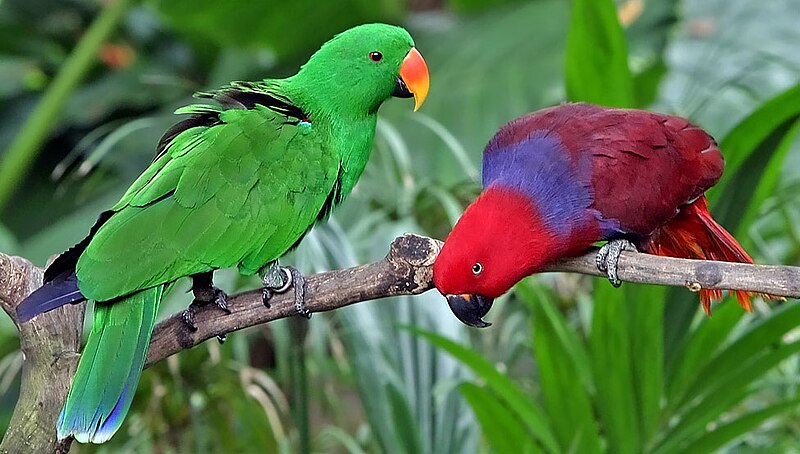 The Eclectus Parrot is well known for an unusual degree of sexual dimorphism (males are emerald green, females bright red) and a breeding strategy wherein several males mate with a single female. But no one expected the results of a recent study: under certain circumstances, mothers will kill their male chicks and raise only females. Other than humans, Eclectus Parrots are the only species known to kill offspring based solely upon gender.
The Eclectus Parrot is well known for an unusual degree of sexual dimorphism (males are emerald green, females bright red) and a breeding strategy wherein several males mate with a single female. But no one expected the results of a recent study: under certain circumstances, mothers will kill their male chicks and raise only females. Other than humans, Eclectus Parrots are the only species known to kill offspring based solely upon gender.
Harsh Conditions and Drastic Adaptations
The study, published in the journal Current Biology (October, 2011), was conducted by researchers based at the Australian National University. The study site was at Cape York, Queensland, in Australia’s tropical northeast (Eclectus Parrots are also found on New Guinea and many Indonesian islands).
The unusual behavior seems driven by the scarcity of safe nesting holes, which are generally located 90 feet or so above ground. Nest sites closer to the ground are vulnerable to flooding, and to predation by scrub pythons and monitor lizards. Females fight viciously over prime nest sites, and may occupy the same one for many years.
Female Eclectus chicks are easier to rear than males, and fledge as much as a week earlier than their brothers. Apparently, time is of the essence during very rainy years, or in particularly vulnerable nests, because females will kill the more “costly” male chicks when certain conditions are met. In doing so, they increase the likelihood of successfully rearing at least 1 chick (only 2 eggs are produced). Details need to be explored, as not every mother in a poor nest site will kill her male offspring, but the pattern is quite clear.
Choosing the Chick’s Sex?
According to some researchers, females that typically use low nest hollows have evolved a way to choose the sex of their offspring, dispensing with males before they are born.
Other Eclectus Strategies
 Some Eclectus Parrot populations are already skewed in favor of females. I wonder if this helps to explain another of their odd breeding behaviors. Unlike most parrots, female Eclectus will mate with multiple males, each of whom will feed her while she is on the nest.
Some Eclectus Parrot populations are already skewed in favor of females. I wonder if this helps to explain another of their odd breeding behaviors. Unlike most parrots, female Eclectus will mate with multiple males, each of whom will feed her while she is on the nest.
Females Eclectus Parrots rarely leave the nest hole during the nesting season, and so rely entirely upon their mate for food. Multiple males were thought to be an “insurance” policy against the death of one. But only a small percentage of females can find and keep safe nest sites. Perhaps the males must share successful females if they are to have any chance of contributing to the next generation?
The fact that even such a popular, well-studied parrot holds such secrets is very exciting…we really never can tell what will come to light next!
Further Reading
Eclectus Parrots in the Wild and Captivity
Video: Eclectus Parrots “Chatting”
Typical and Unique Bird Breeding Strategies
Eclectus pair image referenced from wikipedia and originally posted by Doug Jansen
Eclectus juvenile male image referenced from wikipedia and originally posted by Sergio Almeida
 That Bird Blog – Bird Care and History for Pet Birds
That Bird Blog – Bird Care and History for Pet Birds



